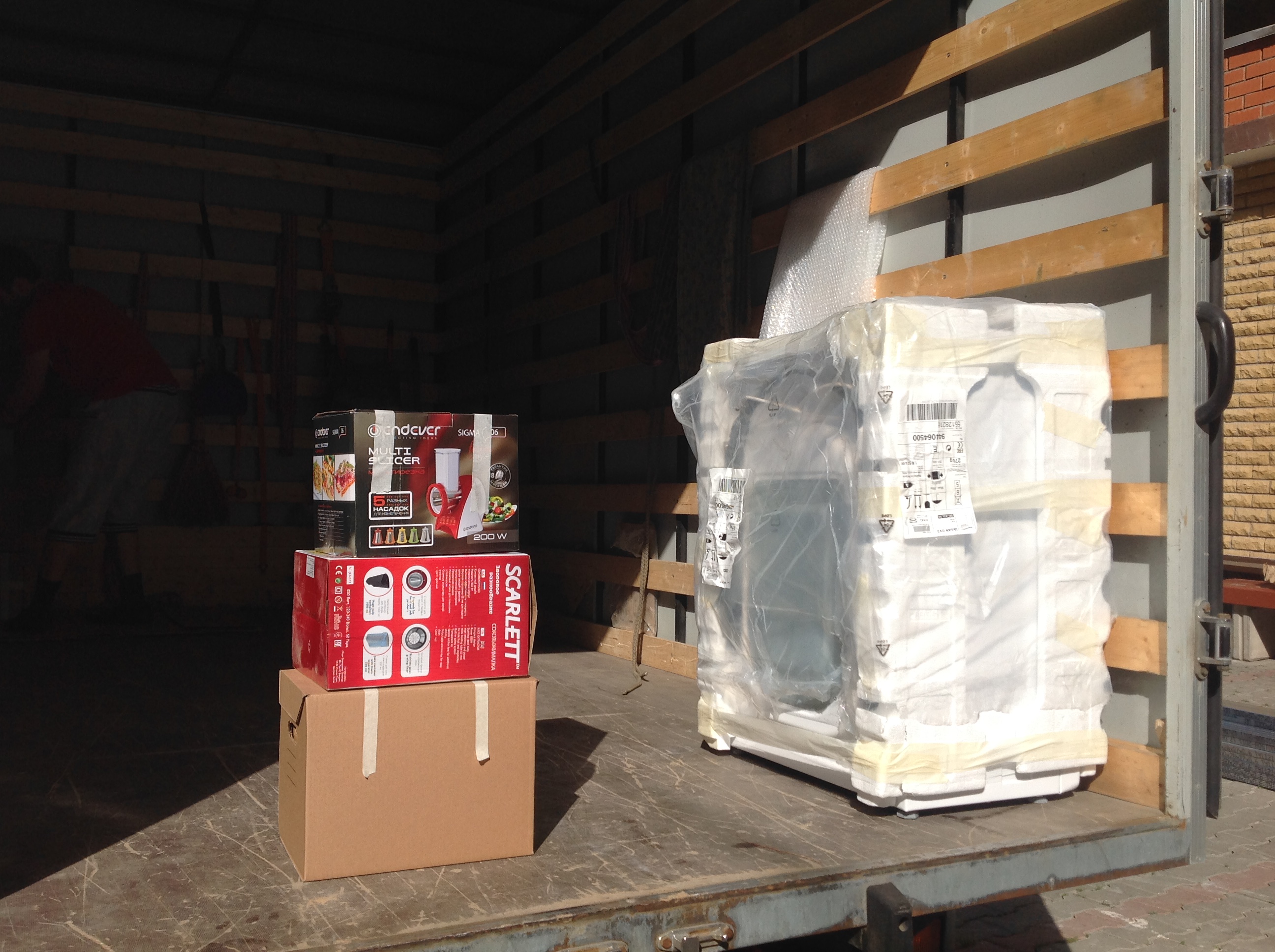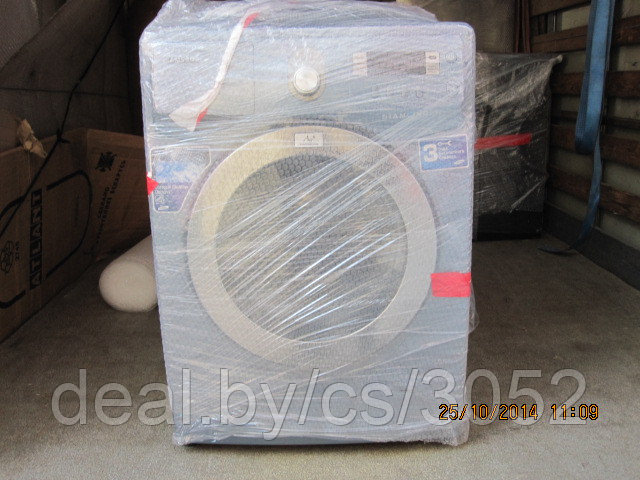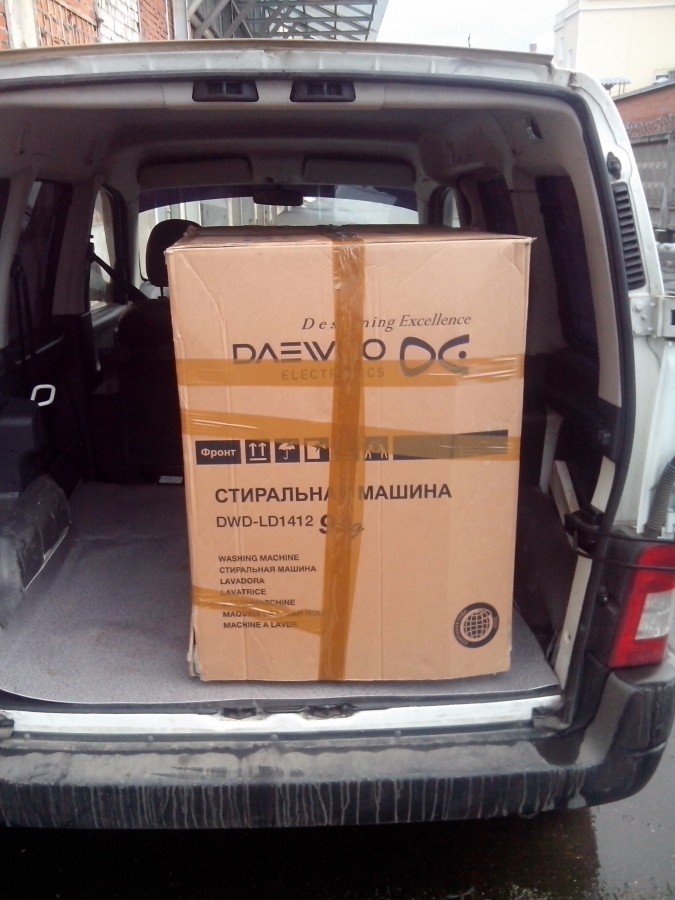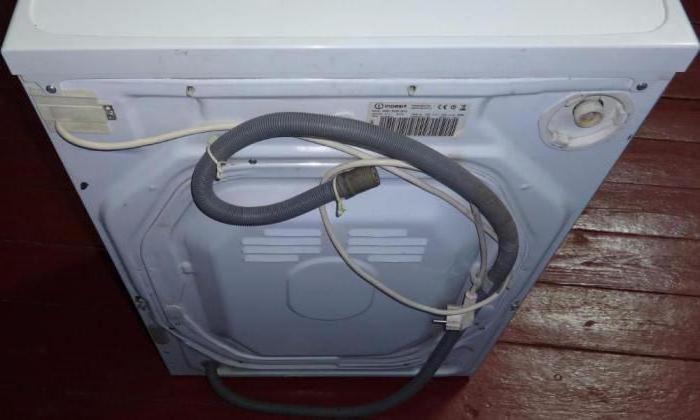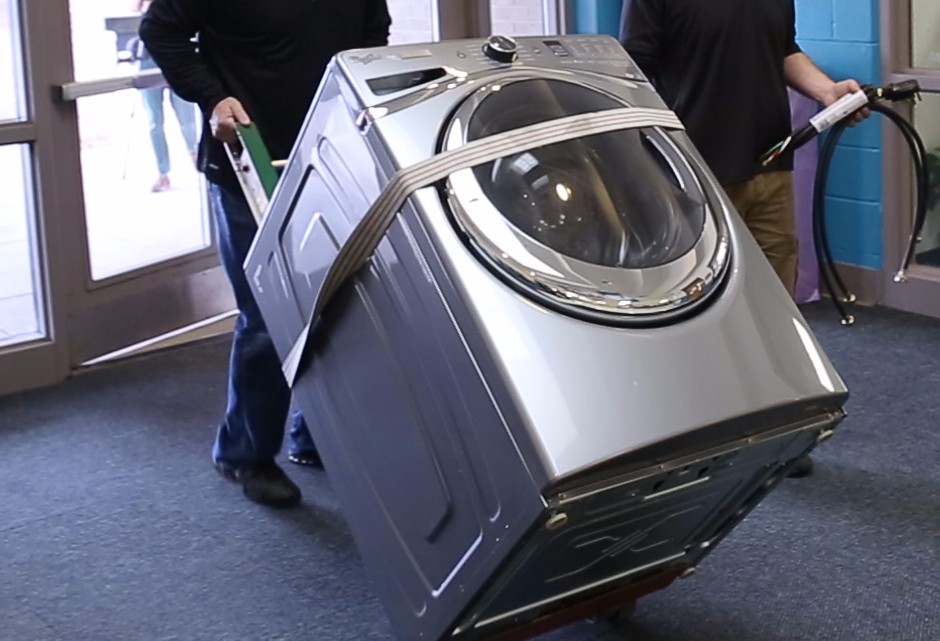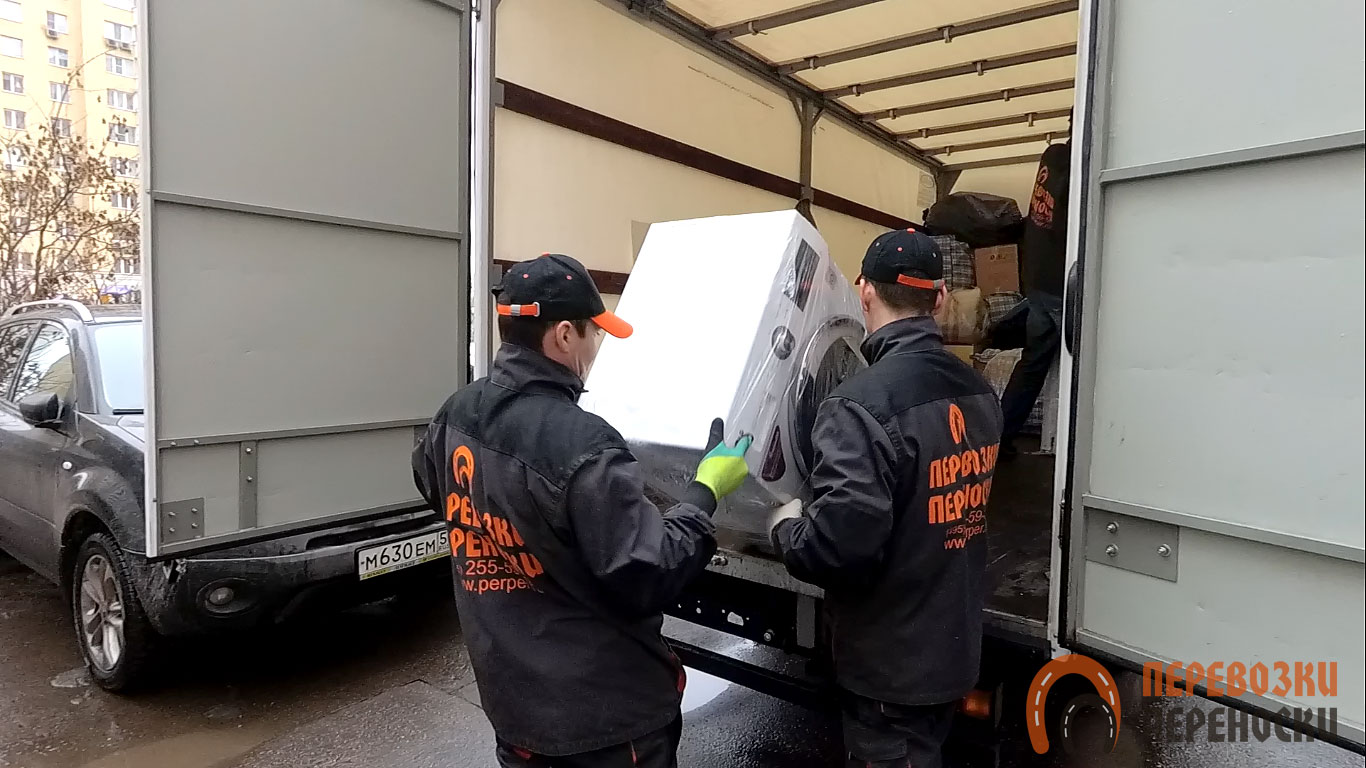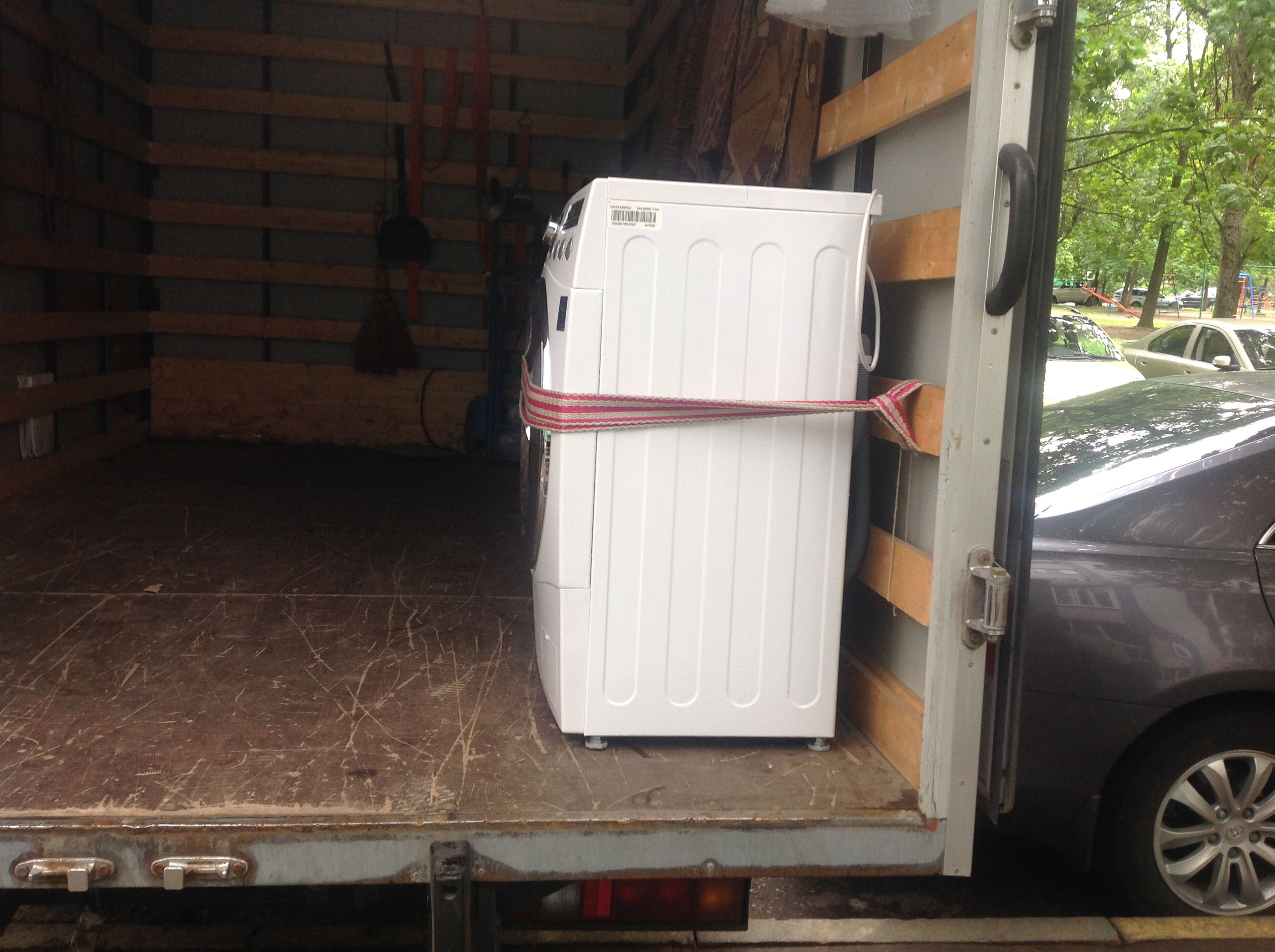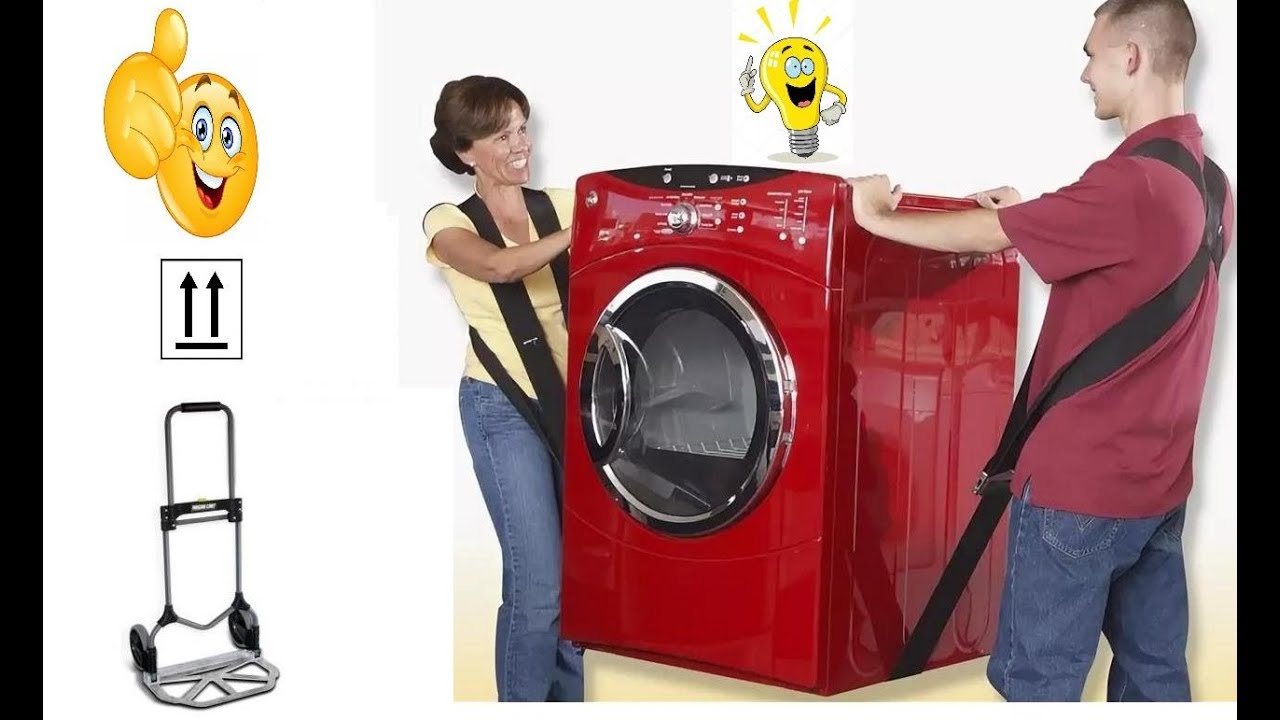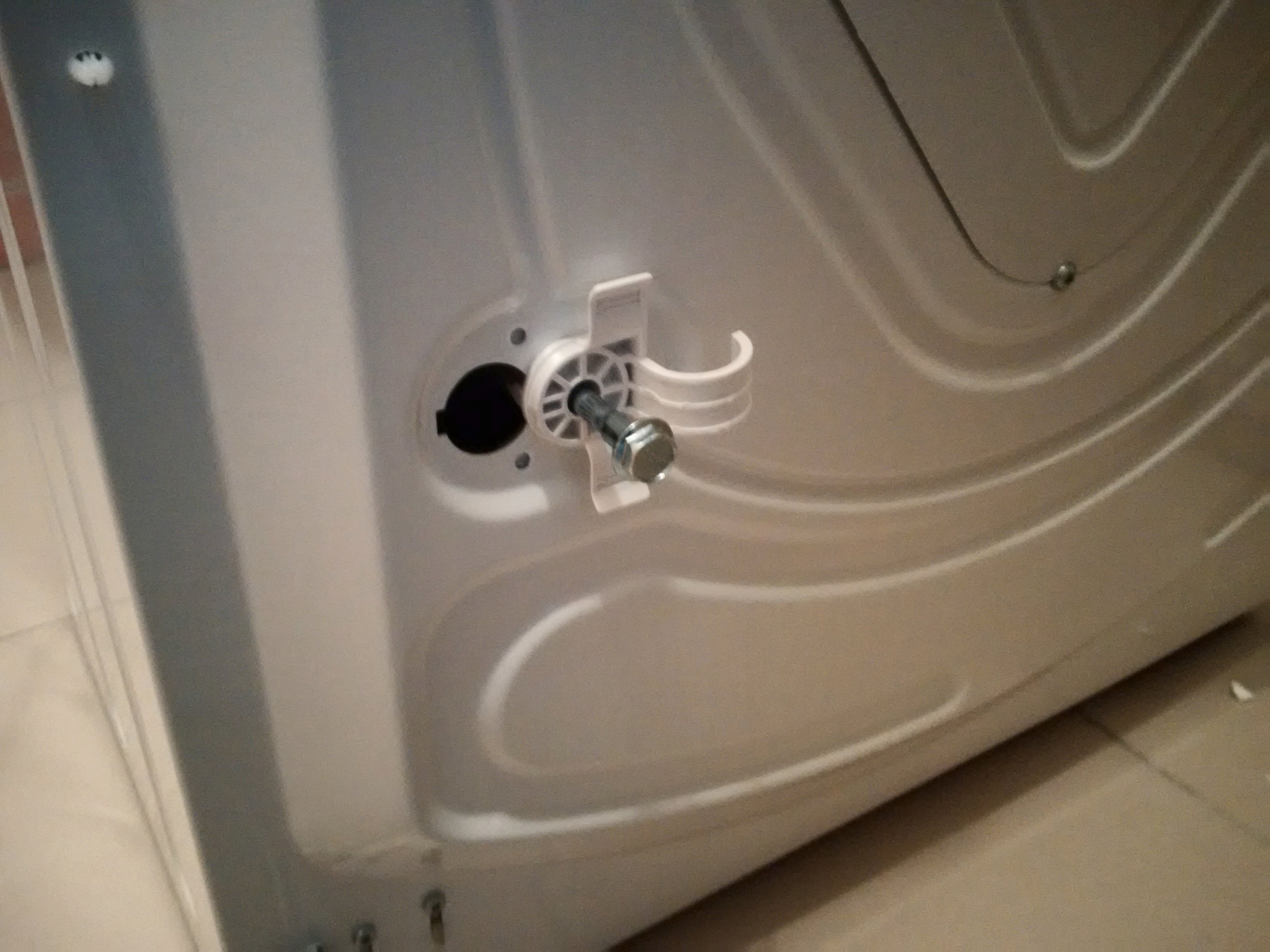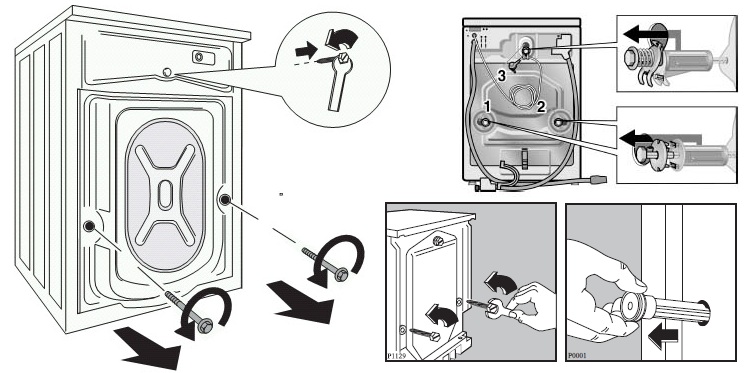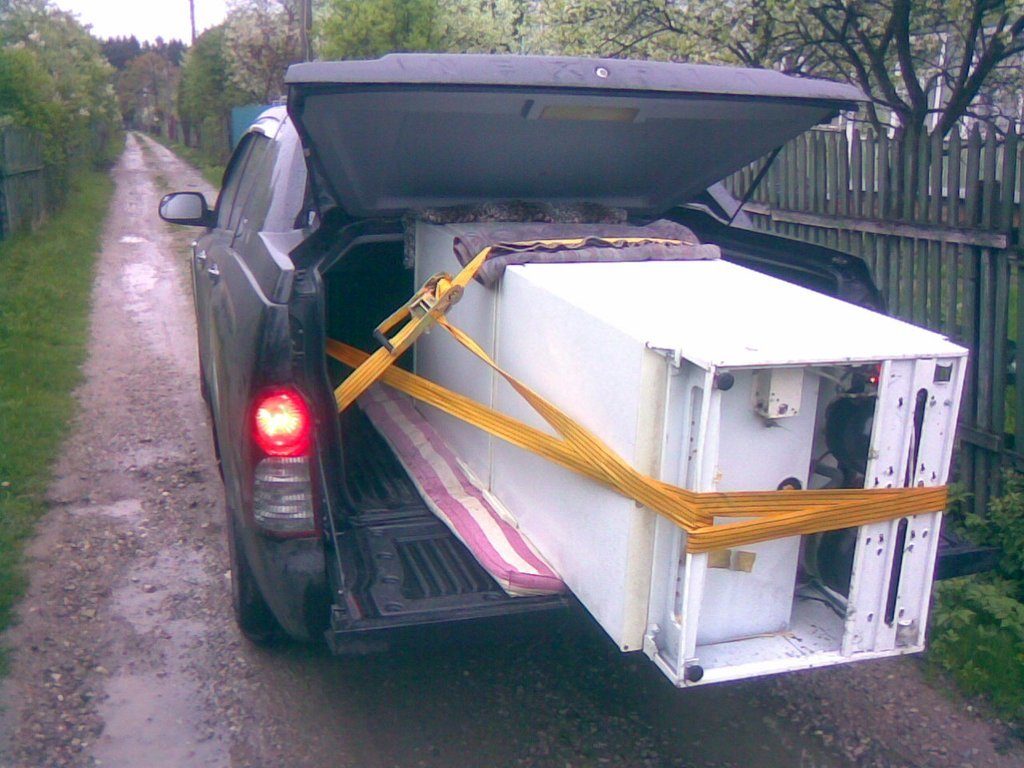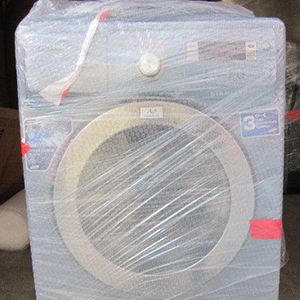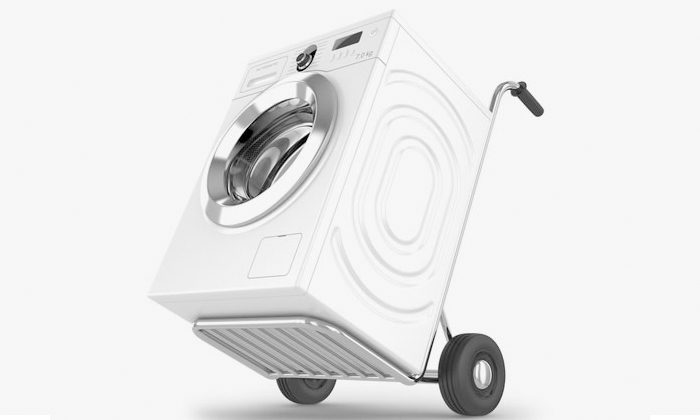How to prepare
First you need to start preparing the washing machine for further transportation.
Disconnection
Experts recommend to disconnect the washing machine from all communications. Therefore, before starting the transportation, the equipment is disconnected from the power sources and disconnected from the sewage system. Also, it is disconnected in advance from the water pipes, which are responsible for the flow of water.
If you do not disconnect all communications in advance, when trying to transport the washing machine, you can damage the sewer or water hoses.
Water removal
Another action that is performed in advance is to drain the remaining fluid from the system. The water often remains in the pump, pipes and hoses, which are responsible for the flow or discharge of water.
Fixing hoses, wires and hatch
Many people choose not to secure the wires and hoses that might be attached to the washer. However, it is better to fix them in advance so that during carrying they do not cling to anything and do not get entangled. They can be fixed with tape to one of the walls or removed altogether.
Tape off sharp corners and parts
Any technique has sharp corners, and the washer is no exception. The main danger of such corners is that they can be scratched and injured. Therefore, for safety reasons, it is better to carefully glue each sharp corner with a thick layer of tape.
Tank fixation
Before shipping, the drum must be securely attached so that it is not accidentally damaged.
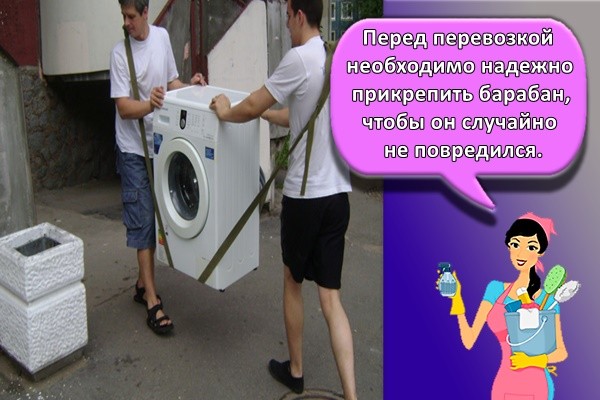
How to install the shipping bolts
Most often, special shipping bolts are used to fasten the tanks of washing equipment. These are the most suitable fasteners recommended by manufacturers. Using these bolts is very simple. To secure the tank, simply insert each bolt into the drilled mounting holes at the back of the machine.
How to transport without shipping bolts
Sometimes people do not have transport fasteners and they have to fix the drum with improvised means. First you need to unscrew the back panel of the structure and place things in the hole between the wall and the tank that can soften the vibrations. To do this, use unnecessary rags, foam rubber or small pieces of foam.
Package
Before transportation, the equipment must be packed so that it is not damaged on the road. Various materials can be used for packaging.
In the factory
The best option for packaging equipment is considered to be the use of a factory box. In this case, it is enough to simply place the washing machine inside the package and carefully pack it so that it does not dangle during transportation. The box must be carefully rewound with tape so that it does not open on the road due to possible shaking.
Textile
People who bought a typewriter more than five years ago rarely have boxes and therefore have to pack the equipment in other ways. Often they use fabric materials, which are completely wrapped around the structure. The fabric is fastened with ordinary tape or adhesive tape.

Corrugated cardboard
You can use corrugated cardboard to pack the washer before shipping. The side walls of the washing equipment, as well as its upper and lower parts, are sheathed with cardboard. Cardboard sheets are fastened together with metal staples or tape.
Stretch film
Many people think that stretch film is used only for wrapping small items, but this is not the case. This material is also suitable for packaging washing machines.
The film is carefully wrapped around the equipment to protect its surface from mechanical damage
Preparation of MCA for transportation
Take care of packing before leaving. The best option is an original box, in the walls of which you put sheets of polystyrene or foam rubber pieces. Of course, the washing machine could have served not 2 or 3 years, which means that you cannot find the factory packaging, not to mention the fasteners and other components. We'll have to get out on our own, improvising with what we have. When preparing the unit for transportation, follow the recommendations of specialists:
Disconnect communications: electricity and hoses connecting the device to the water supply and sewerage system.

Drain the remaining water from the CMA. It can remain in hoses, pipes, powder containers and pump. During transportation, especially on the side, it will surely spill, creating inconvenience and a dangerous situation for the machine itself.
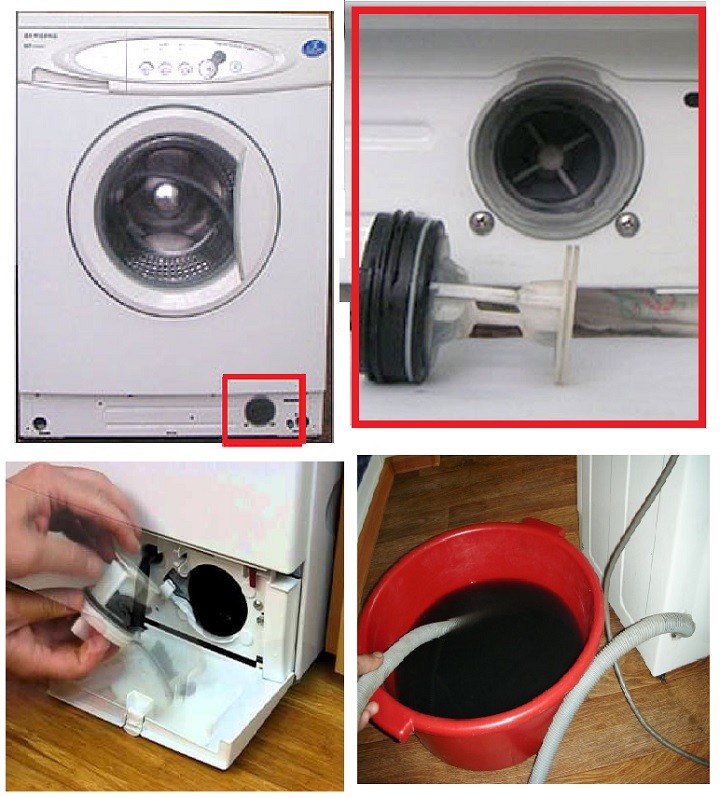
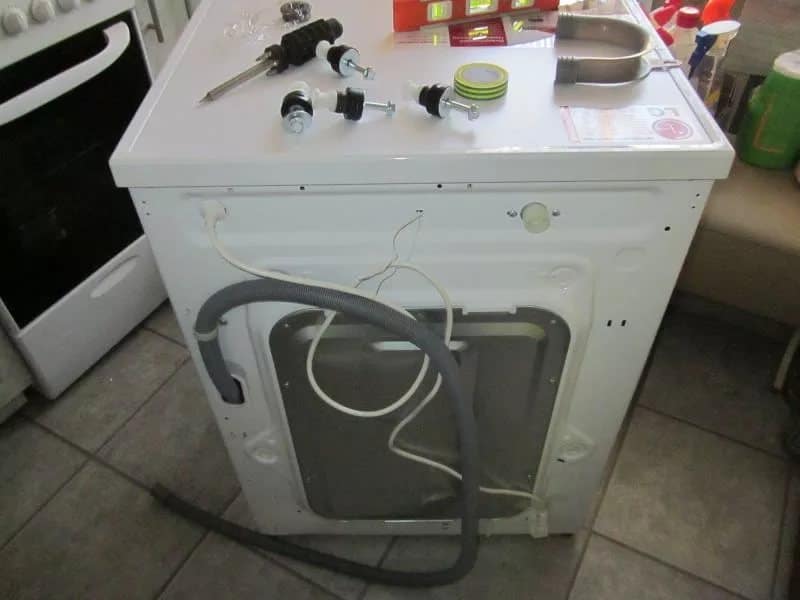
- Using a roll of duct tape, wrap around the sharp edges of the body. Secure the powder intake to prevent it from falling out and breaking.
- The last step is to fix the tank. With a long move to another city, the tank is fixed with transport bolts, the purpose of which we wrote earlier. If they are not preserved, they will have to be transported without the transport bolts. For this, the SMA cover is dismantled, and foam or foam pieces are laid between the tank and the body to fix the drum in the tank. Then these nodes will not suffer from vibrations. You can also use cardboard, unnecessary clothing, etc. Then the cover is screwed into place.
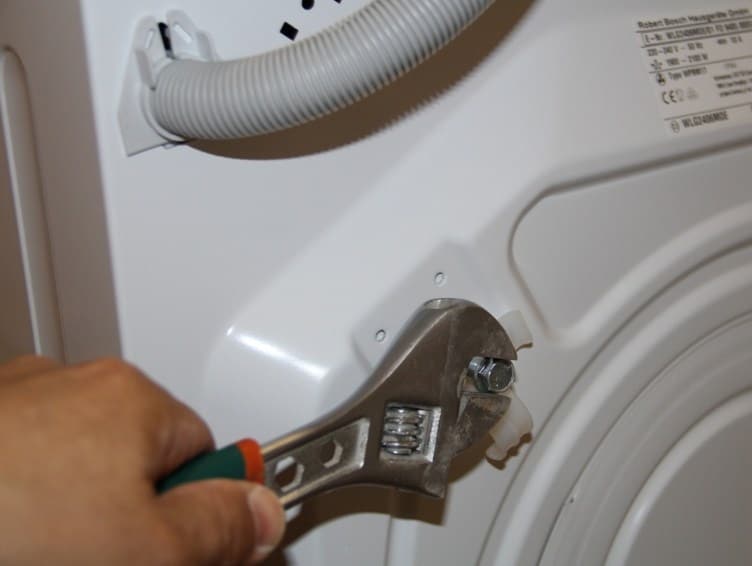
How to pack the CM when moving if there is no box from the store?
After the procedures, wrap the equipment in a cloth (an old bedspread will do) or a film with "pimples" and fix it with a cord or rope. Having done everything neatly and correctly, you can easily transport the washing machine without harming it.
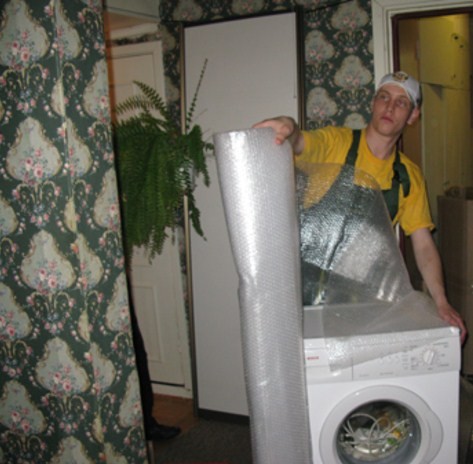
Can I transport without bolts
When buying used household appliances, the bolts may not be present, or they may be lost.
In this case, you need to remove the top wall of the washing machine and fill the free space with soft materials.
Can be used:
- rags;
- Styrofoam;
- foam rubber.
Then the top wall is put in place, secured with fasteners. Even when transported hard, the drum and tub will not themselves be hit and will not damage the inner walls.
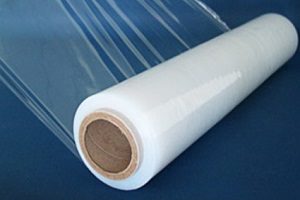 The outer case of the equipment is also packed in:
The outer case of the equipment is also packed in:
- corrugated cardboard;
- stretch film;
- the cloth.
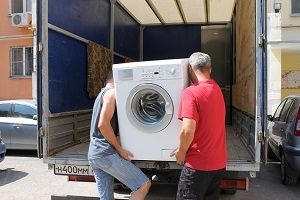 Experienced experts recommend transporting the washing machine in an upright position, while securing the drum and tank.
Experienced experts recommend transporting the washing machine in an upright position, while securing the drum and tank.
When transported in a truck, the automatic machine is installed in the direction of travel sideways.
If other large things are transported in the body, the car must be placed between them so that it does not move and does not jump, does not fall. This eliminates the risk of damaging shock absorbers, contacts and pipes.
Once the machine is packed and ready for transport, it must be safely transported to the vehicle, which can also cause problems. The most difficult thing is to lower the unit from the upper floors without an elevator.
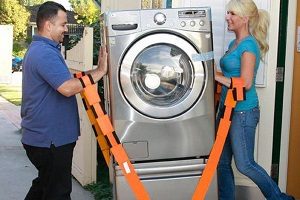 When descending from the floor, it is advisable to keep the equipment in an upright position, in the same way as it will be used.
When descending from the floor, it is advisable to keep the equipment in an upright position, in the same way as it will be used.
If this is not possible, then a lean back is acceptable.
If the packaging was found to be insufficient, there is a risk that the doors will open during transportation. Although they are closed and held with special fasteners, it will not be superfluous to fix them with tape or rope.
The empty drain hose is reeled up and secured with tape or ties. Additionally, they can be wrapped in polyethylene or soft material.
Loading into a car
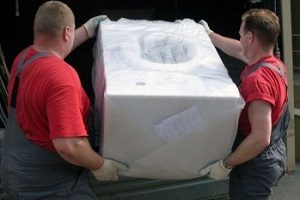 It is easiest to load a car into a truck; questions usually arise with a passenger car.
It is easiest to load a car into a truck; questions usually arise with a passenger car.
There are several positions in which you can transport equipment:
- standing;
- on the side;
- on the back wall.
If the machine will be transported on its side, then it is allowed that the drum and tank are not secured. This opinion is not shared by all experts, so it will not be superfluous to lay foam rubber between the mechanisms.
A used clipper must be completely dry if it is to be transported on its side. Liquid may remain in the powder container. It's not so bad that the body of the car can get wet, as damage to the electronics.
If you are not sure that the container is dry, it is better to wipe it dry or remove it and transport it separately.
Please note: if the washing machine is transported lying down, the powder container should not look up (you need to focus on the model of the unit)

The manufacturer Zanussi differs in that it makes a filler valve near the counterweight. If you put the machine in an unnatural position for it, then the valve breaks.
Before transporting the machine, you can put it on the back wall for a while so that excess water is drained through the drain hose. Of course, the driver should drive as smoothly as possible, without stopping or turning abruptly.
What problems can occur if the rules of transportation are violated
All recommendations that are described above must be strictly followed. If you suddenly forgot to provide for something, then the transportation may end up with an expensive repair, or even the purchase of a new machine.
Here are the main options for the outcome of incorrect transportation:
Additional transportation rules
It is desirable that the machine be fixed in the car body with special belts.
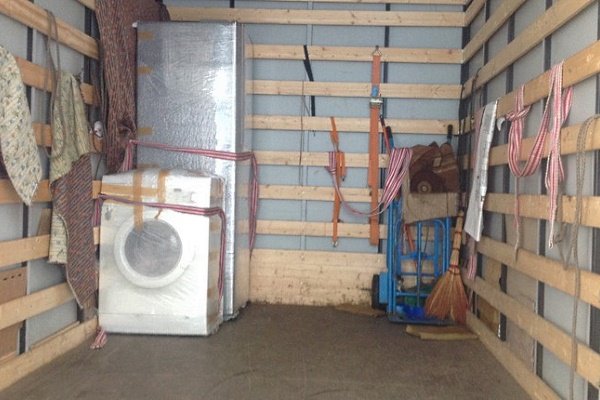
If you are driving a car, try to avoid hard braking and sharp turns.
The rules are quite simple and their observance in 95% of cases guarantees safe transportation of household appliances. Also take the “softest” route without bumpy roads and holes. The recommendations in this article apply to other large household appliances as well.
When buying a washing machine - an automatic machine, as a rule, the store offers on a paid or free basis to bring household appliances to the entrance and even to the apartment. However, there are times when you need to transport the washing machine "on your own".
For example, a family lives far out of town, where delivery by a store's vehicle will cost an order of magnitude more than if the washing machine was transported on its own. Or when moving from one apartment to another, you will also need to transport all household appliances. How to properly transport a washing machine - automatic, and what nuances must be taken into account in this case?
In no case should you put the car on its side, even if this way it fits perfectly in the trunk of a car or on any passenger seat.
It is recommended to transport the washing machine in an upright position. After all, any person drives a vehicle while sitting or standing, but not lying down. This will negatively affect the well-being of the passenger and will threaten his safety.So it is with any household appliances - in order to keep the "insides" of the washing machine unchanged, it should be transported only in an upright position.
To prevent the drum of the washing machine from falling off and loosened, it is necessary to secure it with special transport bolts. These bolts should be included in the standard equipment of the washing machine - automatic. If the manufacturer does not provide for the presence of shipping bolts, you must purchase them additionally. Fortunately, they cost a little by today's standards. At the same time, the family budget will not suffer, but possible repairs will cost a large sum.
Despite the fact that all the doors of the washing machine are closed by means of special fasteners, it would be better to insure yourself and glue them on one tape of tape. So, even with strong shaking and great speed, the doors will not open and break.
And of course, it is worth noting that each automatic washing machine, like any other large-sized household appliances, must be transported in packaging, preferably in the factory one. In this case, the places of contact between the washing machine and the box must be insulated with foam or other soft, but at the same time durable material. This will protect the body of the washing machine from dents and scratches.
The washing machine is an indispensable item in any household. Careful operation in accordance with the instructions will make its service life as long as possible. And each manufacturer in the user manual indicates that it is necessary to properly transport the washing machine while standing. That is, in the position in which it is usually used.
Laying the technique on its side is not entirely correct and should be resorted to only in the absence of other options, however, the vertical position can also adversely affect the drum, which is held by the springs. Therefore, the tank must be well fixed.
Stages of preparing equipment for the move:
- Disconnection from water supply lines;
- Removal of stagnant water from hoses and pipes;
- Fixation of hoses and wires;
- Installation of protection on the corners, wrapping with stretch tape to avoid scratches.
If the original packaging has been preserved from the washing machine, you can put the unit in it. Such a measure will protect the vehicle from damage on the way.
What happens if the rules are violated?
We are not afraid, but if you incorrectly prepare the equipment for transportation and ignore the recommendations of experts, you can pay for this with the serviceability of the AGR. Such troubles can occur:
- Broken power cord.
- Breakage of plastic elements on the case.
- Rubber seal rupture.
- Broken hatch door.
- Cracked door glass.
- Shock absorbers (dampers) may loosen or break.
- Breakage of branch pipes, hoses.
- Wiring, contacts, electronics wet.
- Bummer of the program selector from the user panel.
- Breakdown of the drain pump.
- Breaking out an unfixed dish for detergents.
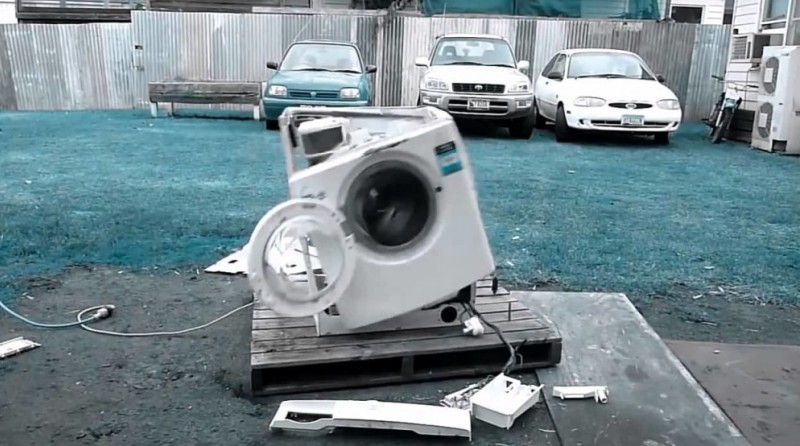
Not every loader knows the above rules. Therefore, it is better to control the process of loading and transportation. Do the preparation yourself or give clear recommendations to the workers. Only in this way will you take the car to the new shelter safe and sound.
It often happens that when moving, people are faced with the inconvenience of transporting a washing machine. Its transportation is complicated by specific requirements, because simply loading it into a car will not be enough. This raises additional questions:
- How to transport the washing machine?
- Is it possible to transport lying on the side panel?
- Can the device be transported without packaging?
- Is it possible to dispense with the shipping bolts?
We will try to answer them in the article.
Before loading the washing machine, you must place it in the original box.
... Additional protection can be provided with a foam pad or foam blocks.This is the best option, but it is rather difficult to fulfill all the listed conditions. In reality, the owners keep the original packaging for several years. Then the box, and with it the standard fasteners, are thrown into a landfill. Therefore, when transporting the device, you will have to do with improvised means.
Transportation of the washing machine is carried out as follows:
- Disconnect the appliance from the power supply and water supply.
- from the drum, hoses, pipes and other system elements. Pay particular attention to the drain pump. Water that has not been removed from the machine can cause trouble during transportation.
- Immobilize pipes, wiring, hoses, and other moving parts. You can do this with scotch tape or plastic clamps. Loose elements can be damaged when transporting and loading the washing machine.
- Pre-tape the protruding parts of the device. This will ensure greater safety of the external parts of the device and the environment. The protected edges will not injure the movers or damage the packaging.
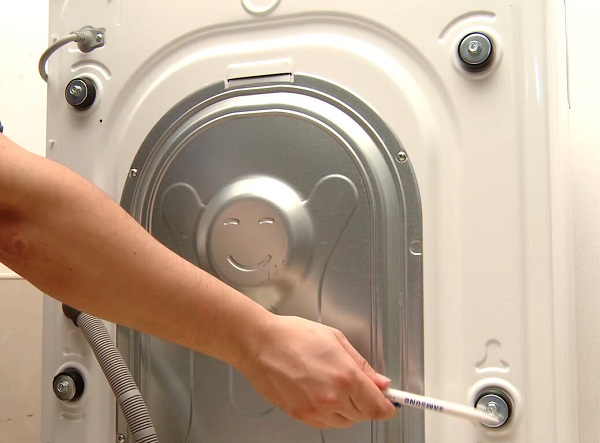
If they are lost, you will have to do without transporting elements and a washing machine. This is necessary for laying safety foam rubber in the space between the tank and the panels of the machine. You can also use foam parts, rags and more for this. After completing this procedure, screw the top panel back on securely.
Having ensured the immobility of the tank, do not forget to protect the outer walls.
cars. Wrap them with a soft cloth, secure everything with a reliable cord. Having performed all these actions, you can be sure that the washing machine will calmly survive the upcoming transportation.
The main thing is to carefully place it in the car and not turn over.
We transport a new unit
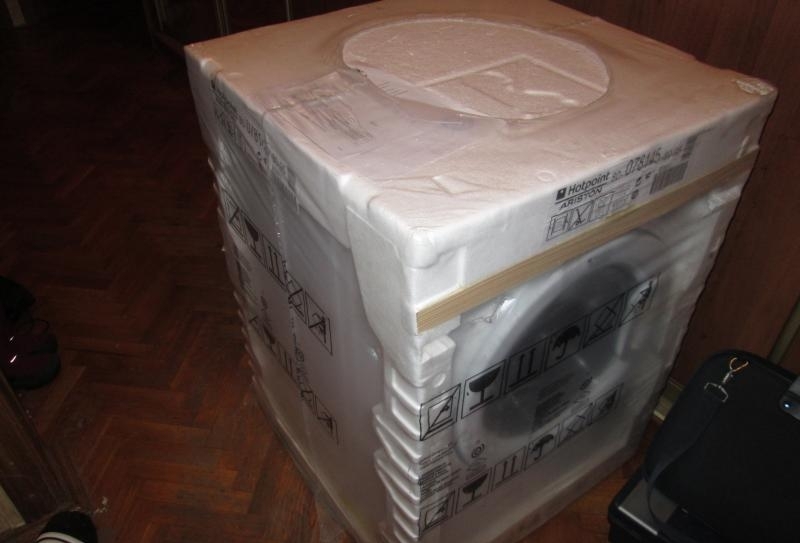
The first time the cars are transported during the purchase from the store to the apartment. Many problems are solved simply - they buy the goods together with delivery to the doorstep. The device is packed in a factory box and has reliable protection against negative manifestations. This option is notable for its convenience, it is used by many trade salons as a free service if an expensive model is purchased.
Not only is there no need to look for a car and people to load, but all responsibility for the integrity of the goods rests with the supplier, which in our case is the store. However, after delivery, it is recommended to check the device immediately - to inspect the integrity of the packaging, completeness, and make sure that there is no damage.
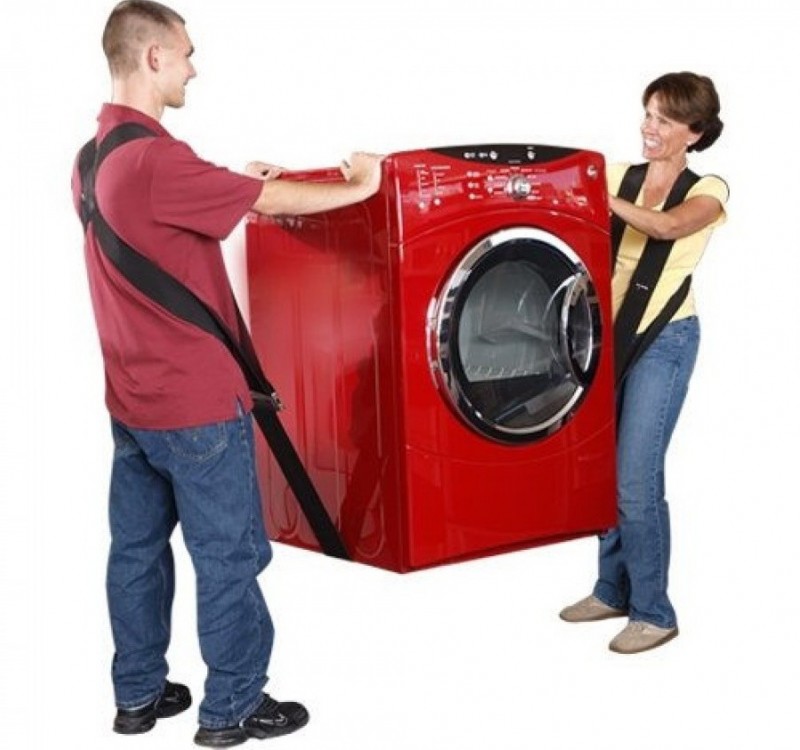
If the machine needs to be lowered from a multi-storey building, then you will have to try not to turn it over. Knowledgeable people assure that the device descends only in an upright state, only slight inclinations are allowed. Such carrying is not possible for one person, so several people will be required for such an operation.
The fact is that during careless carrying or installation, the machine can be easily damaged.
It is not recommended to drag the washing machine "by drag". There is a possibility not only of damage to the floor covering, but also to the body of the unit. The shape of the machine is streamlined, there are no additional handles for carrying, so with any movement it will have to be tilted a little. Before making such "maneuvers" it is better to enlist the help of another person who will insure the device from the opposite side.
If there are no bolts to secure the drum, they can be purchased from a hardware store.
Transporting the washing machine
Once the washing machine is properly prepared for transport, it can be moved and loaded onto a vehicle. Often it is necessary to lower the car from the top floor of a multi-storey building, which is quite difficult considering the size and weight of this equipment. Experts recommend that you do not turn the washing machine over when carrying it to the car. The only thing that is allowed is a slight backward tilt.
Next, you need to decide how to load the automatic washing machine into the vehicle. There are several options for the correct loading of the washing machine, the choice of the option depends on the characteristics of the car. If it is a large truck, everything is easier, if a domestic passenger car is more complicated. You can transport the car:
- in a natural position - standing;
- on the side wall;
- on the back wall.
According to experts, the best option for transporting a washing machine is standing, provided that the tank is fixed. The car should be turned sideways in the direction of movement of the car. Moreover, if there are other overall things in the truck body, you need to put the washing machine so that it is sandwiched between them. In this case, the shock absorbers will remain intact and no branch pipes and contacts will be damaged.
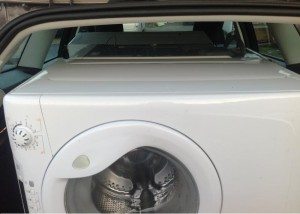 It will also be nice if you put the washer on its side during transportation. In this case, according to some experts, it will not even be necessary to fix the tank of the machine. But we, for our part, recommend that you, even with this type of transportation, either screw in the shipping bolts, or fix the tank with foam rubber.
It will also be nice if you put the washer on its side during transportation. In this case, according to some experts, it will not even be necessary to fix the tank of the machine. But we, for our part, recommend that you, even with this type of transportation, either screw in the shipping bolts, or fix the tank with foam rubber.
When placing the machine on its side, be aware of the powder drawer. The fact is that the water accumulated in the cuvette, when the machine is turned on its side, flows out onto the contacts of the control panel and this can lead to damage to the electronics. Therefore, when transporting the machine on its side, remove the powder drawer and put it separately. Or wipe it dry from the inside with a cloth.
If your washing machine is of any make and model other than Zanussi, then it can be safely transported lying on the back wall. In Zanussi washing machines, there is a filler valve in the immediate vicinity of the counterweights. If you put the machine on the back wall, then the counterweight rests on the filler valve and breaks it.
What happens if you violate the rules of preparation and transportation?
Violation of the rules for the preparation and transportation of the washing machine can lead to the most adverse consequences. Just one bad trip to the washing machine can send it straight to the landfill - no kidding! Here are some typical problems you might encounter.
- The integrity of the power cord is compromised.
- The plastic parts of the washing machine break.
- The cuff breaks and the hatch mounts break.
- Tank shock absorbers fail.
- Hoses and pipes are torn.
- Wet and close electrical wiring and contacts.
- The control panel toggle switch breaks off.
- The drain pump breaks down.
- The loose powder cuvette breaks out.
Summing up, we note how even an experienced loader does not always know how to transport a washing machine correctly. Before transportation, the "washing machine" must be prepared, and only then correctly placed in the vehicle. Otherwise, there is a chance that after handicraft transportation, this piece of household appliances will not work.
How do I remove the transit bolts?
Bolts are simply necessary for transporting the washing machine, but when used as intended, they will only get in the way. Therefore, before starting the first wash of the laundry, they must be unscrewed without fail.
This is no less important than the correct installation of this type of household appliances and its careful operation.
In advance, we recommend that you pay attention to the fact that if your machine breaks down due to the fact that you forgot to remove the bolts, then this breakdown will only be on your conscience. And no service center will repair your new, but already broken car under warranty.
That is, in order for it to be repaired, you will have to pay.
Finding the shipping bolts in your washing machine is easy. They are located on the back of the case. Usually there are from three to four pieces. There are brands of typewriters that use metal pins instead.It is found in household appliances produced under the Millet and Burning brand. It is rare, but it still happens that some special models have a specific bolt arrangement. For example, in one car they were found under the upper part of the body.
In order to unscrew the bolts, you will need a regular wrench of the correct size (usually 10 to 14 mm). If you don't have a key, you can use pliers. The shipping pins are removed with pliers. In order to get them, you need to grab them with pliers and turn them to the side a quarter of a turn. Then they can be freely removed from the case.
The holes that remain from the bolts should be plugged with plastic plugs. These plugs are included with the kit. The meaning of the presence of plugs is more decorative than practical. Although it is possible that their presence may slightly reduce the noise produced by the machine during washing.
Is it dangerous to transport a washing machine lying down?
As they say, if you can't, but really want to, then you can
Yes, there are some risks, but by paying attention to certain points, you can avoid problems.
Be sure to drain the water and let dry. It is better to be puzzled by this in advance, and not on the day of transportation;
Secure the moving parts: door, powder tray. Nothing should be revealed on the road;
The most vulnerable section of the unit when moving is the drum. Optimally, look for old mounting bolts from it. If they are not there, then you have to improvise. Make fabric and foam pads
High-quality fastening is extremely important, otherwise the main functional part of the device may not only be crumpled on the road, but also tear off;
Cover the surface of the car with blankets or other thick, soft and non-slippery material. Do not forget to secure the clipper after loading.
Place your valuable cargo in such a way that the powder compartment is not on top.
Most often, residual water remains in this unit, which during the event can fill the block with electronics.
Easy delivery! In which case, we are ready to help!
It is much easier to transport a washing machine that you just bought in a store than a used one, because the manufacturer has made sure that it is reliably protected from shock and other mechanical damage.
In addition, a good half of dealers offer delivery, and sometimes installation, completely free of charge, especially when it comes to buying equipment in the mid-price or premium segment. It is also worth noting that if the seller will transport the washing machine, then all the problems that arose along the way fall on his shoulders, and you just have to indicate the address and the convenient time. In any case, when buying new equipment of such a plan, it is better not to stint and pay for delivery. This will save you a lot of hassle.
How to load into a vehicle
Here a lot depends on the type of car that is chosen for transportation. If a truck is chosen, there will be much fewer problems, if a passenger car, the task will be much more difficult.
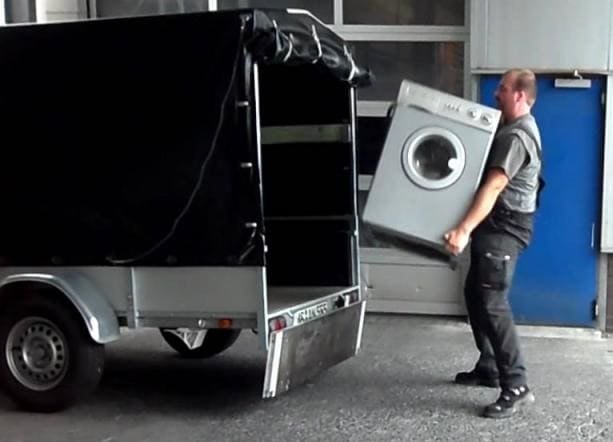
Correct loading of the washing machine
The car can be transported in the following ways:
- The main option (the safest) is in the working position, that is, vertically.
- Rear wall supported, except for some brands such as Zanussi. On this model, the structure is made in such a way that when it rolls over onto the back wall, the counterweight can fall onto the filler valve and break it.
- The most undesirable way of transportation is on the side.
It is clear that it is easiest to carry out the option in an upright position in a truck. At the same time, for the safety of the shock absorbers, you should position the washing machine sideways in the direction of travel and furnish it with other things as tightly as possible.
I work in the field of household appliances repair. Extensive experience in refurbishing washing machines and dishwashers.
In extreme cases, if all options disappear, transportation on the side is allowed. In this case, it is necessary to apply the existing methods of strengthening the washing machine in the car. The driver must have a professional vehicle ownership, especially when driving on rough roads and tight turns.
The consequences can be even worse if the washing machine is transported upside down. In this position, there is a very high risk of losing the pump and the remaining water in the system (it may be present in it, even if it was drained) to disable the electronics of the machine. In this case, there is a chance to think about buying new household appliances.
There is another problem with transportation. When transportation takes place in unfavorable weather conditions, such as rain or the wind raises dust on the roads, you should give the washing machine time to “acclimatize” before turning it on in a new place. Home appliance electronics, consisting of boards and processors, are very sensitive to condensation and dust and may malfunction when turned on. It takes time to remove temperature extremes that cause condensation. If necessary, thoroughly purge the contents of the electronic unit.
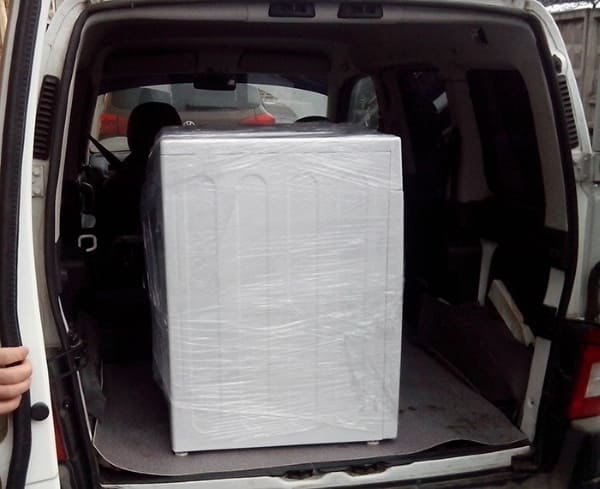
This is how you need to transport the washing machine
Preparation
Preparation for transportation of SMA - automatic washing machine.
“> SMA is the main factor in the success of this event. It is almost unrealistic to assume that the original packaging has been preserved. However, it is necessary to take the time to find the shipping bolts. They are needed to secure the drum, one of the most important and fragile parts of the machine.
In the rear wall there are bolt holes through which the tank is fixed. These technological fastening elements do not allow him to move inside the machine when it tilts during transportation. Thus, both the tank itself and other parts responsible for the performance are preserved from damage: shock absorbers, bearings, body panels.
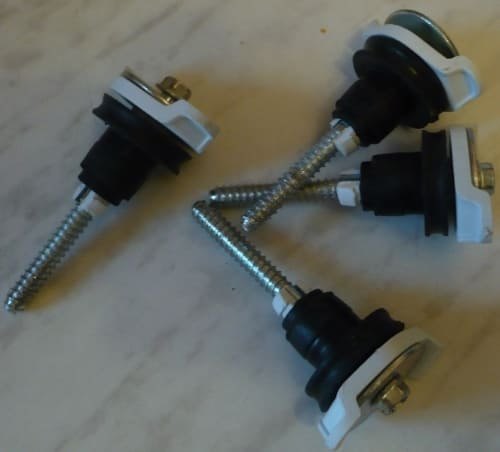
Considering the importance of the transport bolts when moving the washing machine, take measures to keep them safe for a long time. One of the options is to fix it on the back wall of the washer, packing it in a special plastic bag
If no shipping bolts were found, the drum can be secured using materials such as corrugated board, foam, soft cloth. To do this, you need to remove the top or back walls of the machine (two are possible at once) and fill the free space between the drum and the body with the specified material. After that, put the walls in place, after checking the tightness of the tank packing.

Before designing your homemade packaging, you need to do the following:
- fix the electrical wiring and water hoses to the body;
- drain off all the water that may have remained in the washing machine system (hoses, pump, drain);
- dry, leaving the linen loading lid open;
- wipe dry the container for the powder, secure it with tape to prevent it from falling out during transportation;
- for machines with vertical loading, only the hatch is required to be fixed, since the powder container is built into it or is absent;
- for convenience when carrying it by hand, tape the sharp parts of the washing machine with tape.
After carrying out the above actions, in order to prevent damage to the CMA case, an automatic washing machine.
«> CMA, it must be packed. For this it is necessary to use materials that can soften the possible shock load. Usually, there are stretch film, corrugated cardboard, air bubble film. In case of a shortage of these materials, you can wrap the machine with a blanket. Be sure to secure this sheath tightly with twine.
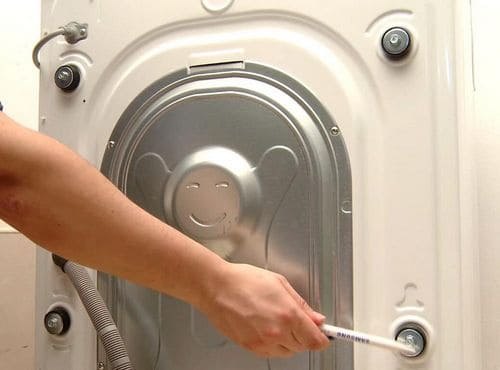
Video
From the following video, you will find out whether it is possible to transport the washing machine on its side, and also familiarize yourself with the rules for carrying and transporting the unit.
She graduated from the Institute of Tourism of the FPU with a degree in "Manager", she loves to travel and communicate with people. She is interested in psychology, enjoys dancing, studying English. For five years of maternity leave, she thoroughly mastered housekeeping, not forgetting about her own development. He skillfully wields words, can keep up a conversation on any topic due to his interest in different spheres of life.
Found a bug? Highlight it and press the buttons:
4.8571428571429
Rating 4.9 (14 votes)
Interesting!
For washing small items on the road or in a hotel, it is convenient to use a regular plastic bag. Knead socks or tights inside a tied bag along with water and a little detergent. This method allows you to pre-soak things and perform washing without damaging the fabric and without spending a lot of powder and water.
History knows the fact when a kitten got into the drum of a washing machine and, having gone through a full cycle of washing on the "Woolen things" program, got out of the unit safe and sound. The only nuisance for the pet was an allergy to washing powder.
In the 19th century, washing ladies' toilets took a lot of time. The dresses were unpicked beforehand, and then washed and dried each part separately so that the fabric would not deform. After washing, the clothes were sewn again.
There are a variety of balls that are used in a washing machine. Antistatic ones will prevent fabrics from sticking to the body after washing, balls with special loops will "comb" the villi and prevent the appearance of pellets, and silicone ones with pimples will prevent fluff from falling off when washing outerwear.
Washing machines are related to the origin of the expression “money laundering”. In the 1930s, American gangsters used the laundry network as a cover for their illegal activities. By passing off the proceeds of crime for the proceeds from cleaning clothes, they turned dirty money into clean money.
Astronauts, while in Earth orbit, solve the problem of dirty things with an original method. Clothes are thrown off a spaceship and burned up in the upper atmosphere.
There is a "bachelor" washing machine. The laundry washed in this unit does not need to be ironed at all! The thing is that the device does not have a drum: some of the items can be placed inside the container directly on hangers (for example, jackets and shirts), and smaller items (for example, underwear and socks) - on special shelves.
The first officially patented washing machine was made of wood and was a box with a frame, half filled with wooden balls. Laundry for washing, detergent was loaded inside and with the help of a lever the frame was moved, which, in turn, made the balls move and rub the laundry.
Washing machines equipped with the "No Iron" or "Easy Iron" functions can wash your laundry without wrinkling it. This effect is achieved due to a special approach to spinning - it is performed at low speeds, with long pauses, and a small amount of water remains in the tank.
The washing machine is an indispensable item in any household. Careful operation in accordance with the instructions will make its service life as long as possible. And each manufacturer in the user manual indicates that it is necessary to properly transport the washing machine while standing. That is, in the position in which it is usually used.
Laying the technique on its side is not entirely correct and should be resorted to only in the absence of other options, however, the vertical position can also adversely affect the drum, which is held by the springs. Therefore, the tank must be well fixed.
Stages of preparing equipment for the move:
- Disconnection from water supply lines;
- Removal of stagnant water from hoses and pipes;
- Fixation of hoses and wires;
- Installation of protection on the corners, wrapping with stretch tape to avoid scratches.
If the original packaging has been preserved from the washing machine, you can put the unit in it. Such a measure will protect the vehicle from damage on the way.








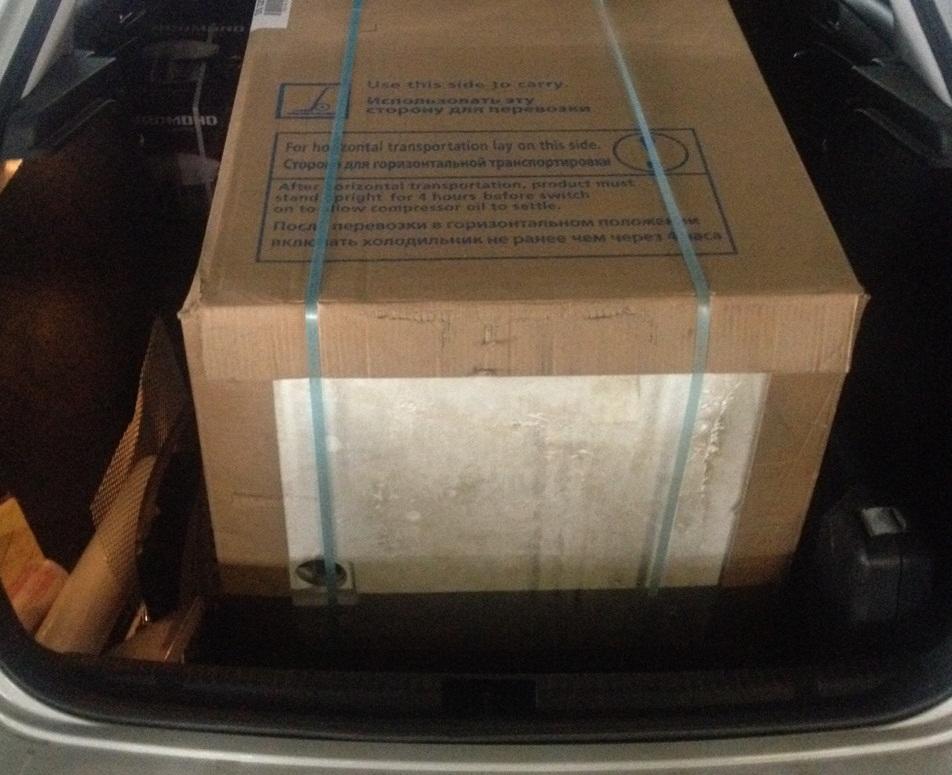
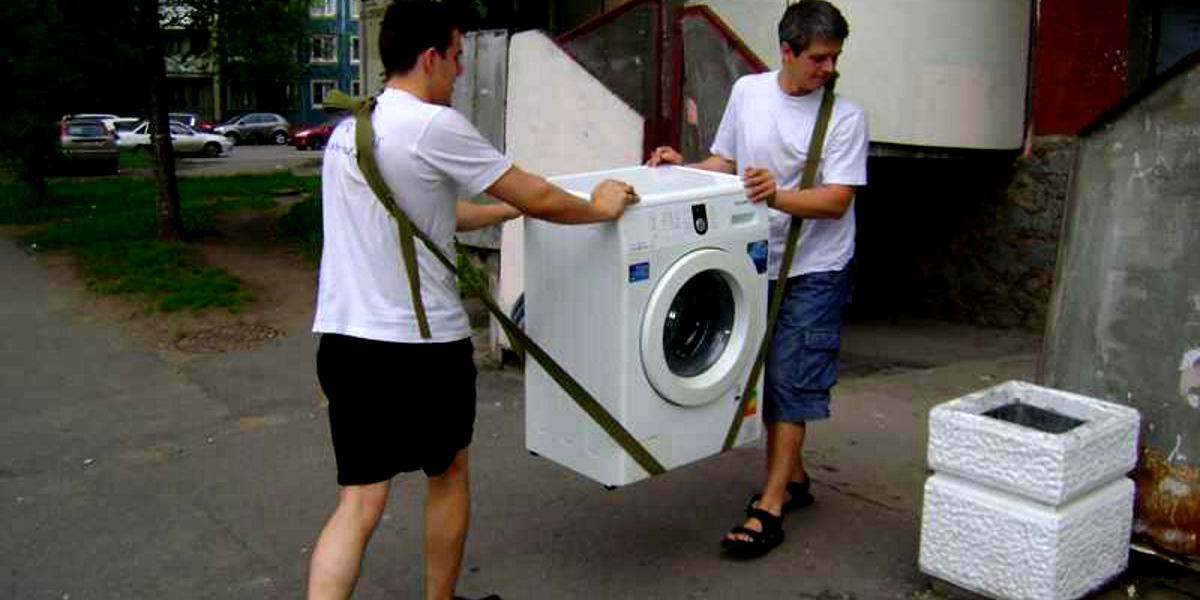
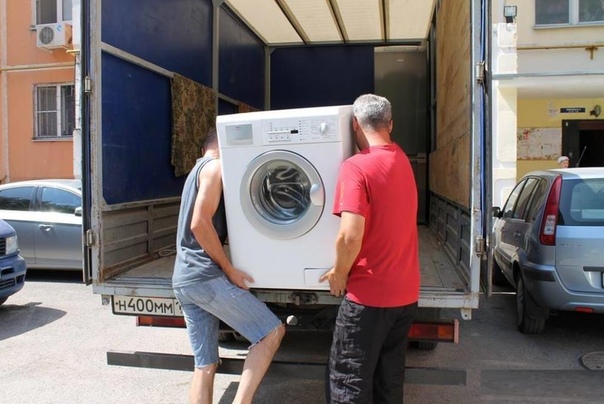
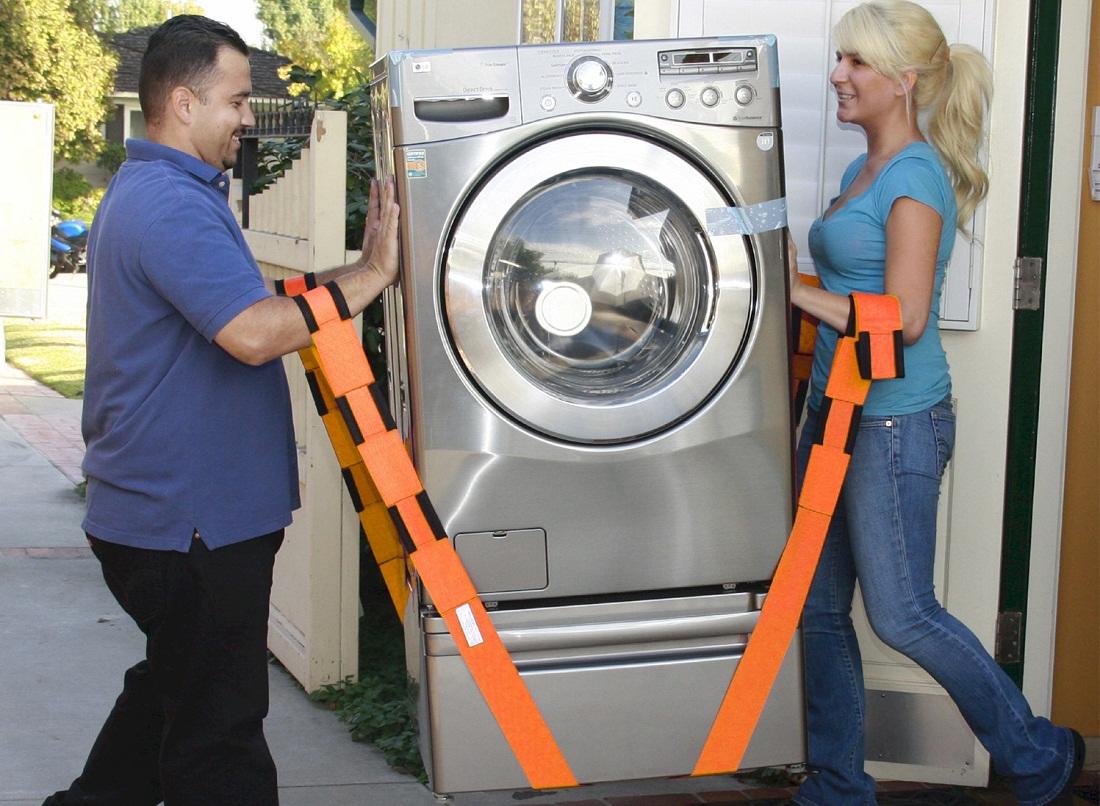

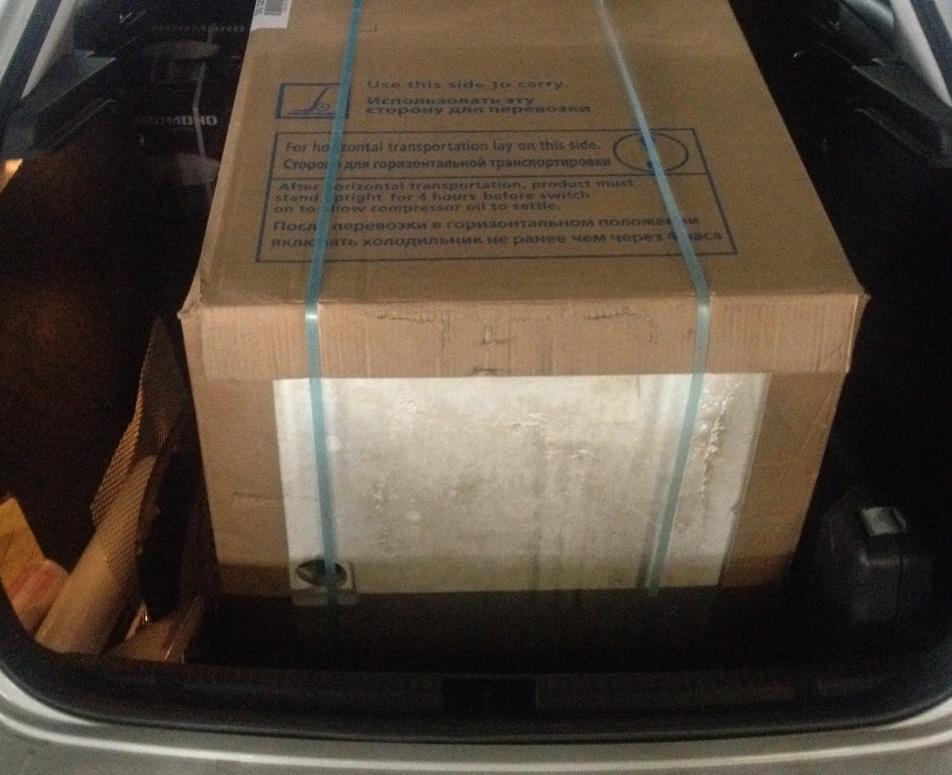

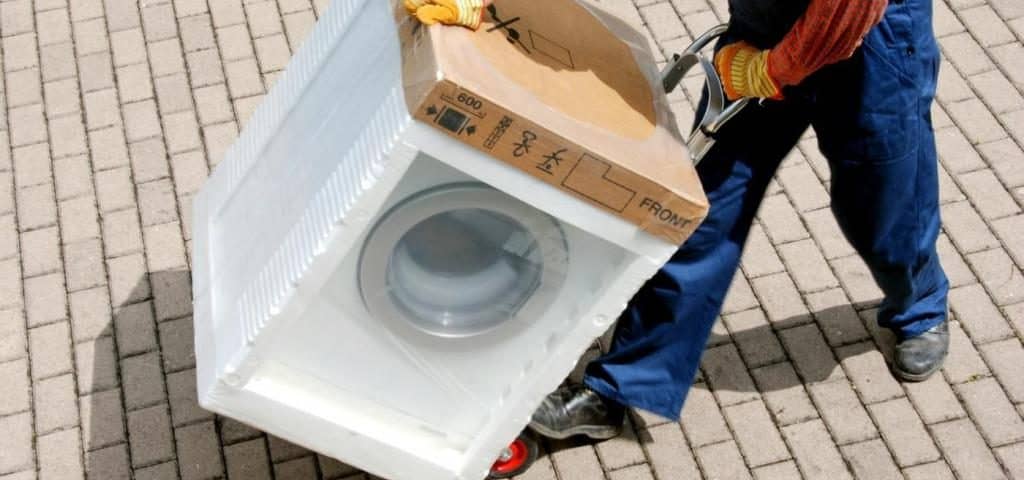

 The outer case of the equipment is also packed in:
The outer case of the equipment is also packed in: Experienced experts recommend transporting the washing machine in an upright position, while securing the drum and tank.
Experienced experts recommend transporting the washing machine in an upright position, while securing the drum and tank. When descending from the floor, it is advisable to keep the equipment in an upright position, in the same way as it will be used.
When descending from the floor, it is advisable to keep the equipment in an upright position, in the same way as it will be used. It is easiest to load a car into a truck; questions usually arise with a passenger car.
It is easiest to load a car into a truck; questions usually arise with a passenger car.

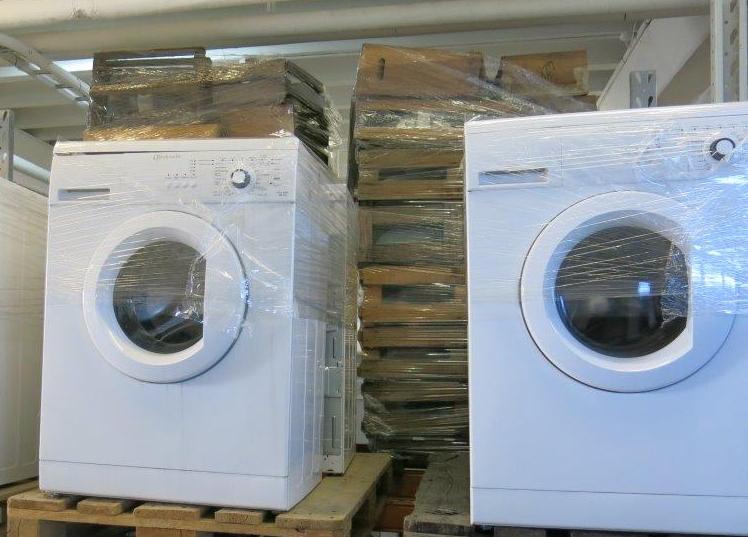
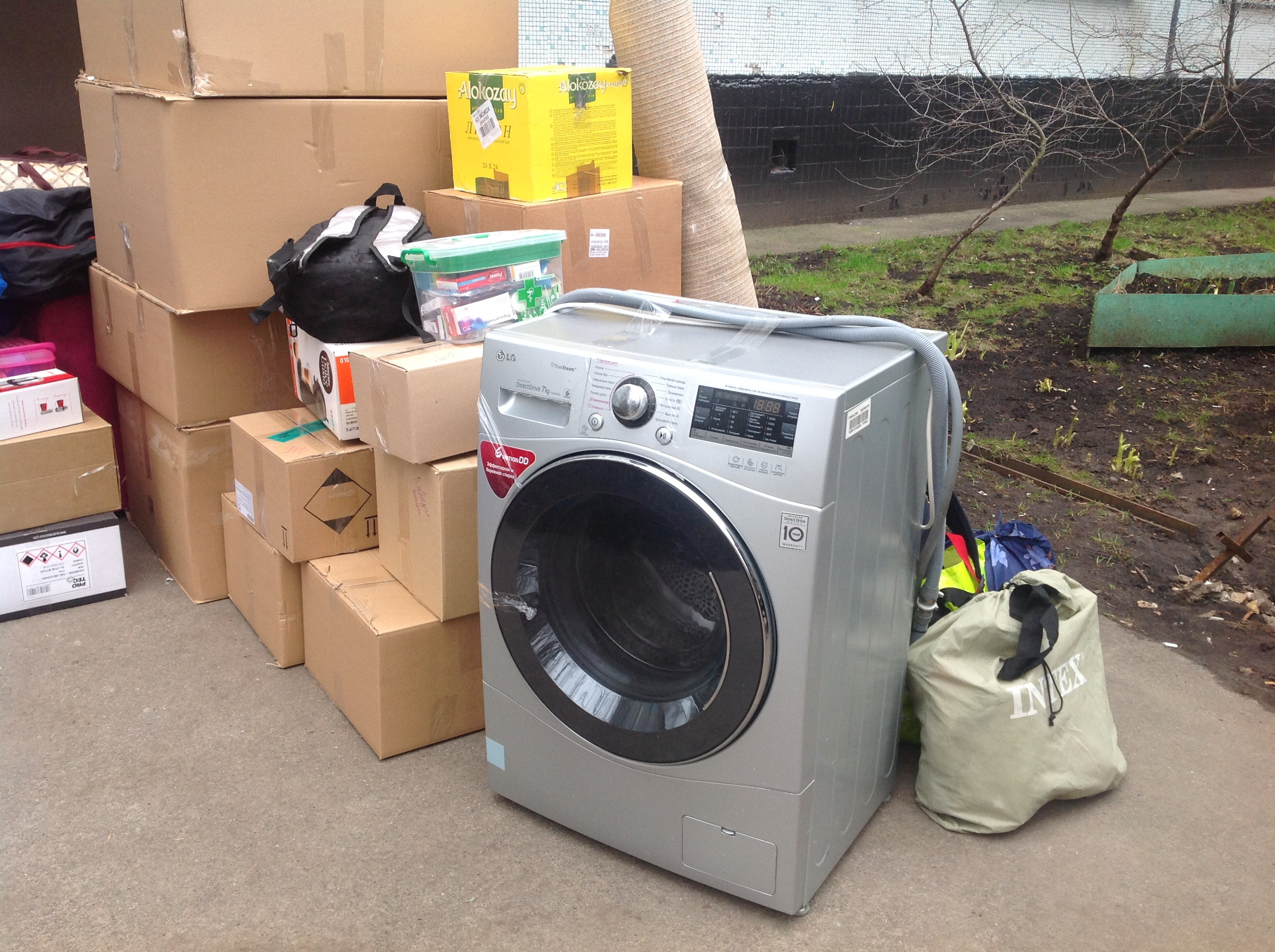

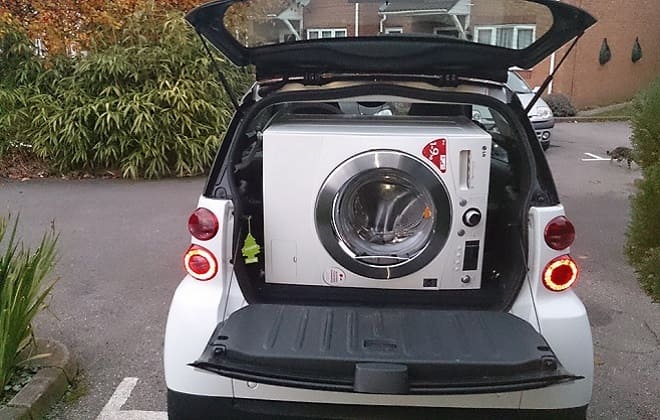
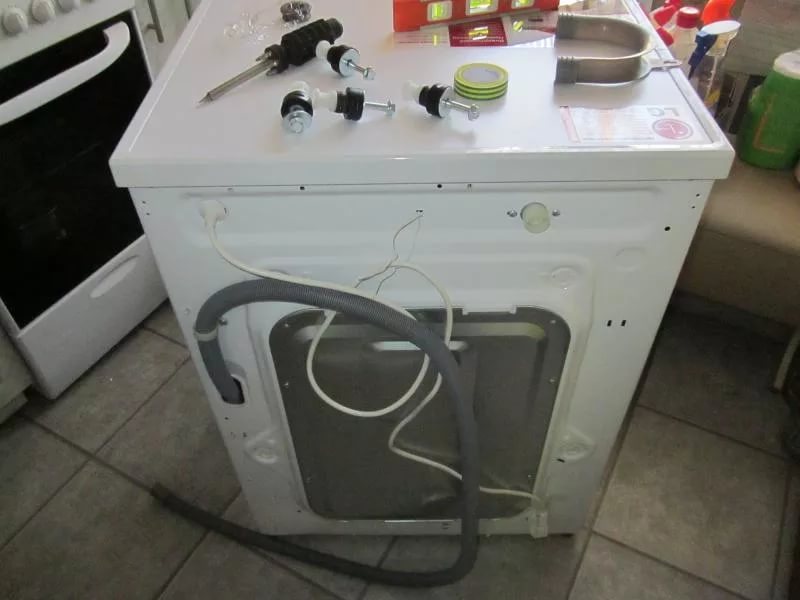
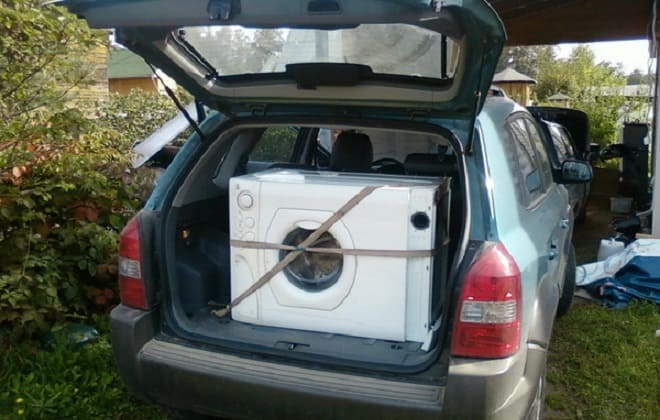

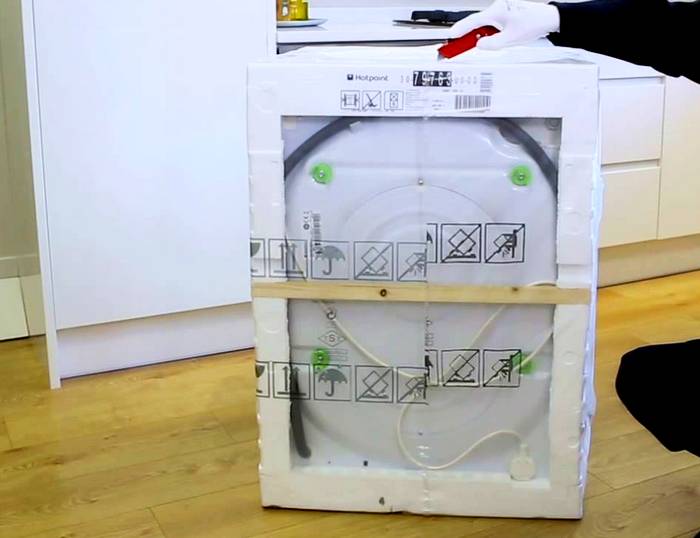
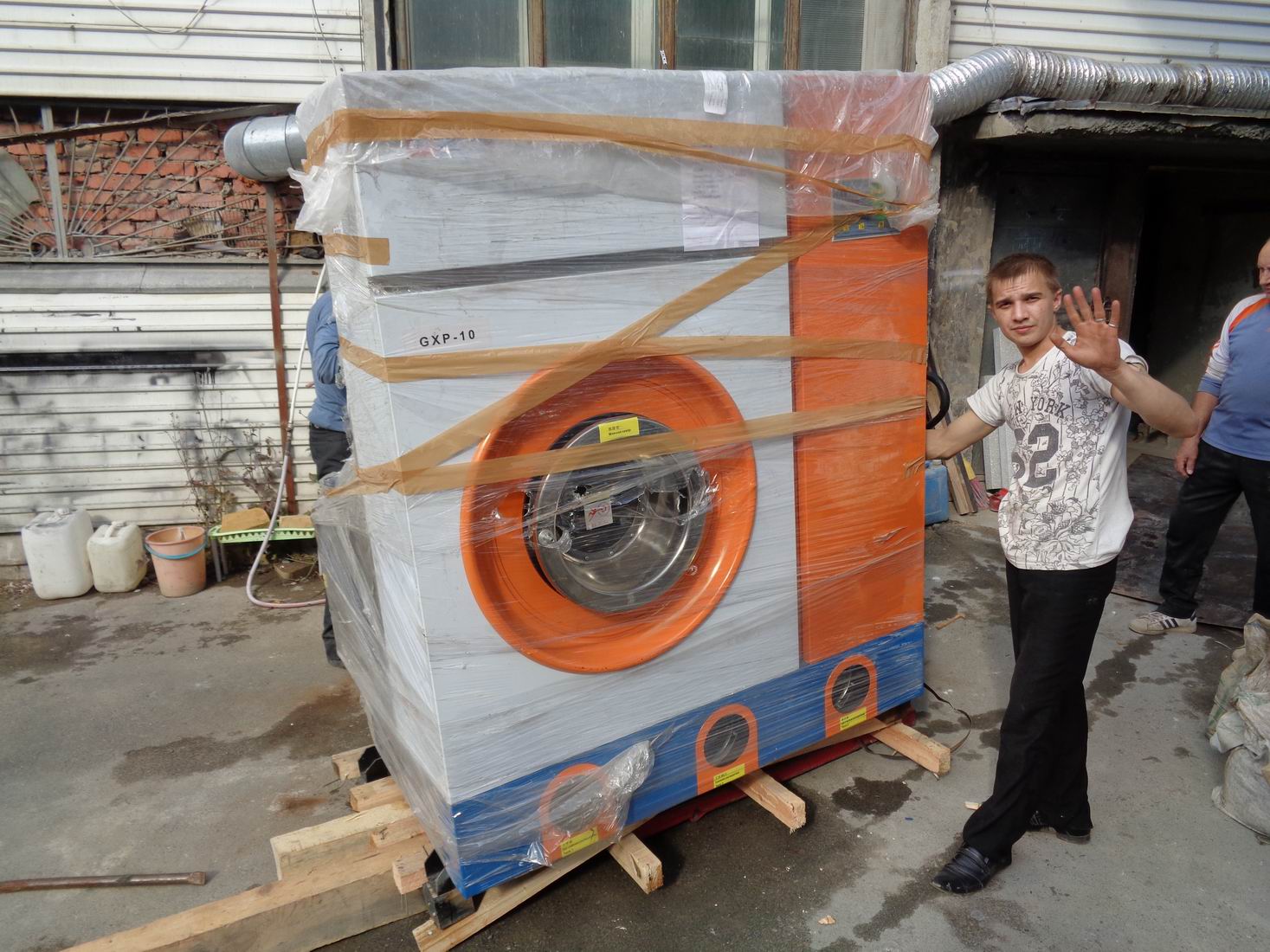
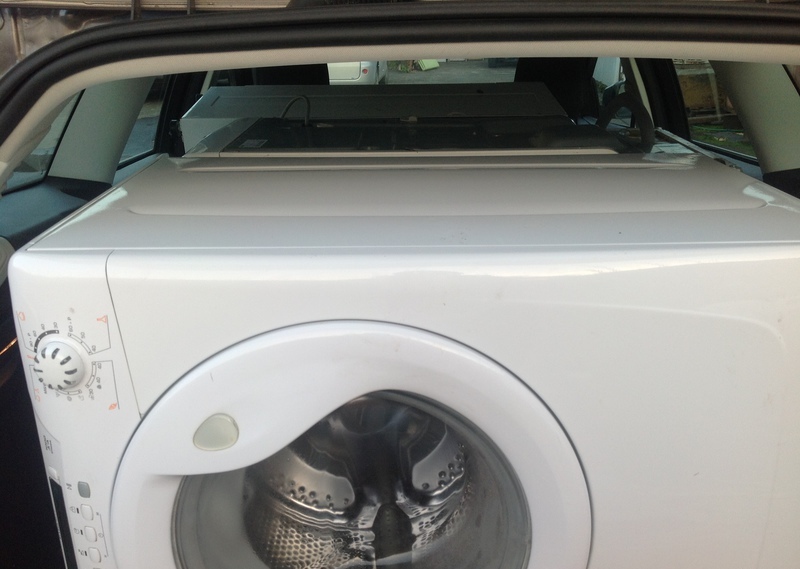




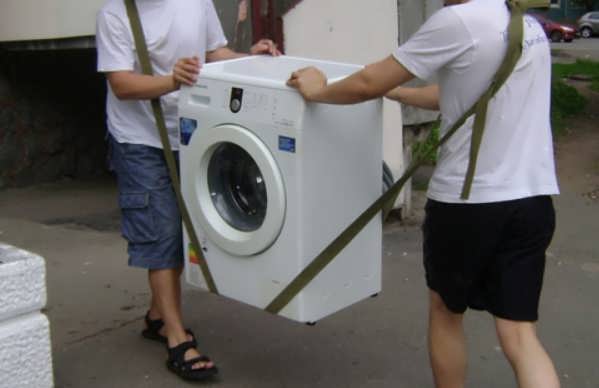
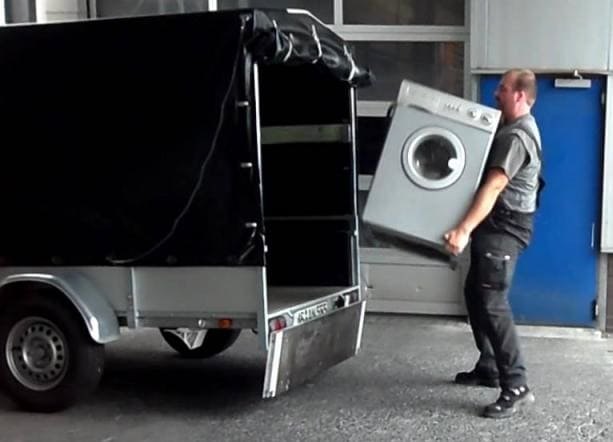
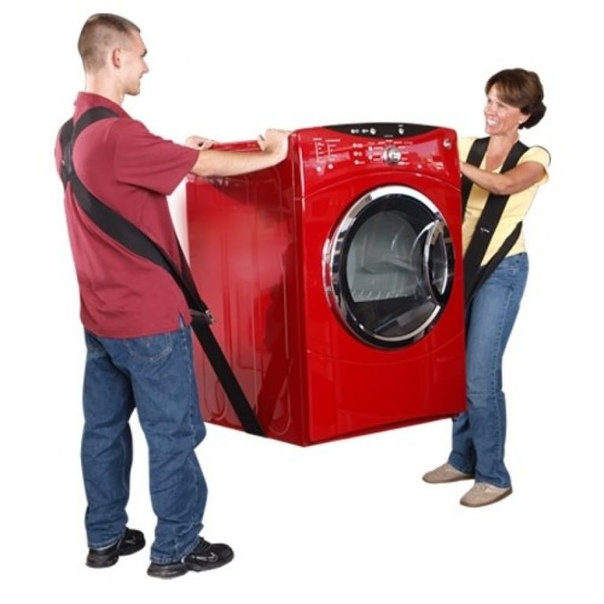

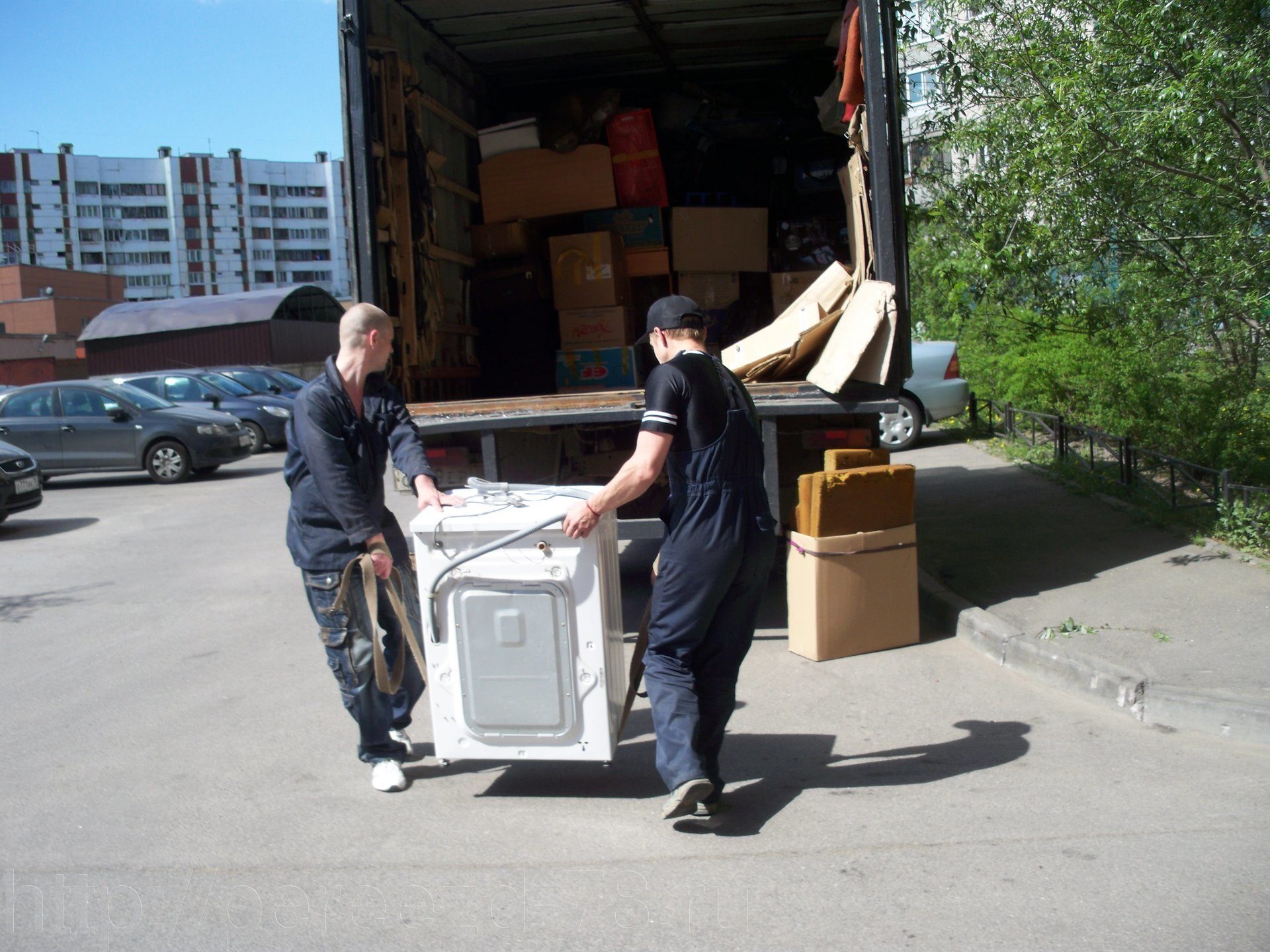



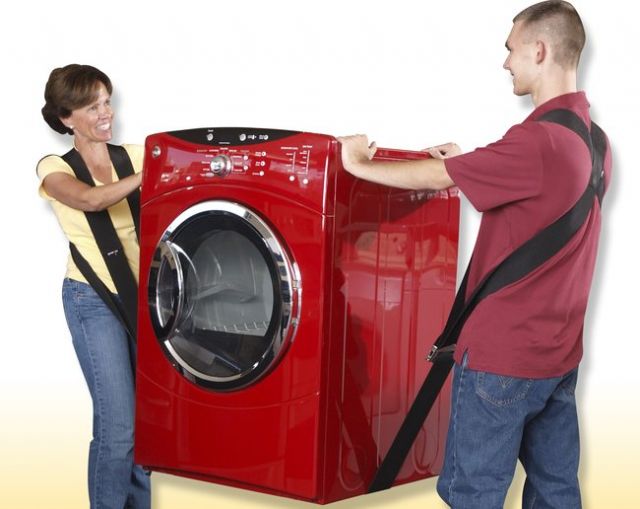
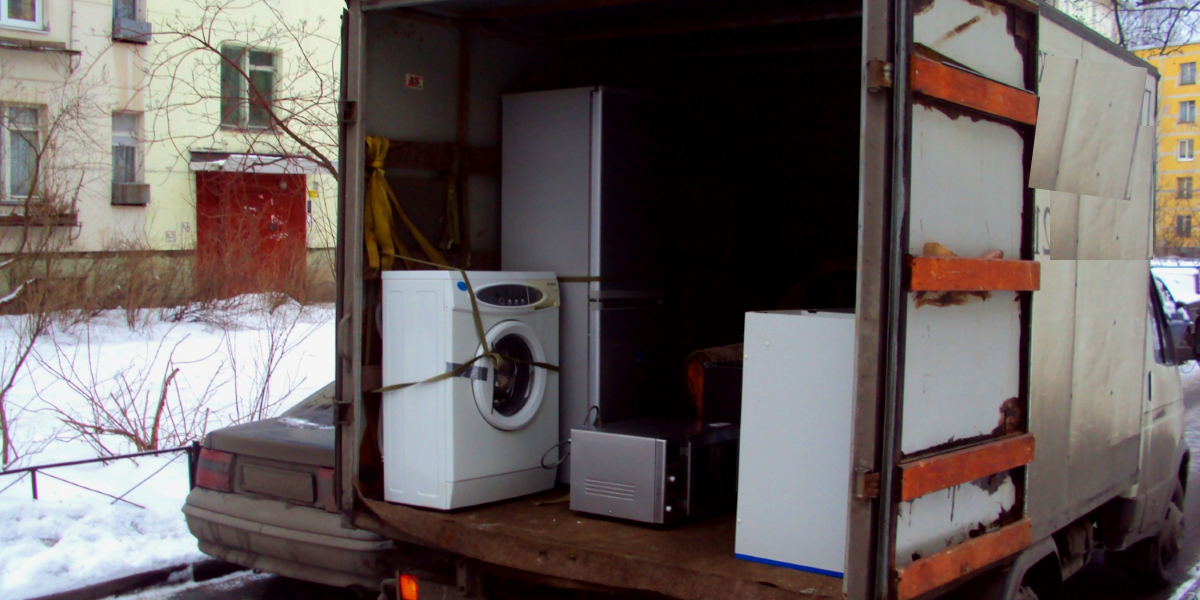
 It will also be nice if you put the washer on its side during transportation. In this case, according to some experts, it will not even be necessary to fix the tank of the machine. But we, for our part, recommend that you, even with this type of transportation, either screw in the shipping bolts, or fix the tank with foam rubber.
It will also be nice if you put the washer on its side during transportation. In this case, according to some experts, it will not even be necessary to fix the tank of the machine. But we, for our part, recommend that you, even with this type of transportation, either screw in the shipping bolts, or fix the tank with foam rubber.